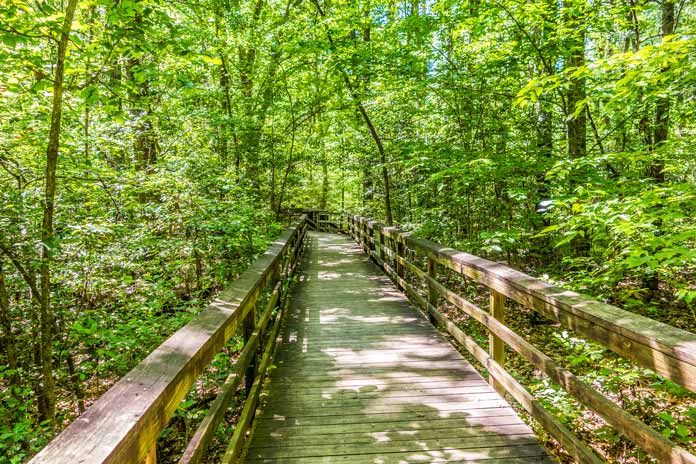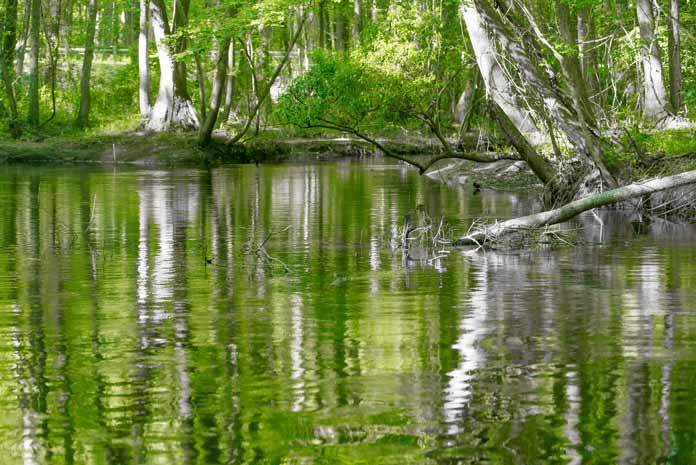Congaree National Park is famous for its trees, and not just any trees. This park has the largest portion of old-growth bottomland hardwood forest in the entire United States. The old growth forest is about some of the ancient woodlands that are significant in age and that have never been disturbed. The trees have large canopies, and layers of them, producing an amazing forest scene that looks like it has been there for thousands of years. The trees receive ample water from the floodplain near the river which is periodically covered by water as the river expands or floods. The name “Congaree” derives from the Native Americans that lived in the area centuries ago. Explore Congaree and see the largest temperate deciduous forests in the world that have largely untouched and undisturbed.
Table of Contents
Hike the Forest of Congaree National Park
What better way to experience Congaree than to hike the ancient and amazing forest? Hikers should beware when walking. Due to the location of the woods in a floodplain, trails can often be muddy and unstable. They are, however, usually flat with little elevation gain, making them easier to walk. The visitor center has trail maps, and all of the trails are well marked, so you know where to go. The Boardwalk Loop Trail is unmarked but leads visitors along a beautiful boardwalk that has been constructed through the heart of the old-growth forest. There are benches along the way to stop and take in the sights or rest if needed along the 2 and a half mile trail.
The Bluff Trail is about 2-mile long roundtrip. Along this walk, you can see evidence of prescribed burns and see longleaf pines that tower above. The Weston Lake Loop Trail covers about 4 miles and has excellent views of Cedar Creek where otters and birds are known to live and have been seen. The Oakridge Trail is longer at 6 and a half miles but crosses through a beautiful stretch of old-growth forest and some huge oak trees as well. Watch for deer and wild turkeys on this lovely walk. The River Trail travels to the heart of Congaree to the Congaree River. The river overflows many times during the year, supporting the ancient forest and watering the trees and vegetation there. This trail continues for 10 miles roundtrip, so wear good hiking boots and make sure the water level has receded.
Birders will love the Kingsnake Trail that is approximately 11 miles roundtrip. Cedar Creek is nearby, and the vegetation is thick and lush, proving the perfect habitats for many species of birds. Bates Ferry Trail is about 2 miles of hiking where colonial era ferries were said to have crossed. Be careful at the steep banks of the river because it can be slippery. The last trail is the Longleaf Trail that is less than half of a mile long and branches off from the Bluff trail to head to the Longleaf Campground.

Canoeing and Trails
Have you ever canoed the river as a trail? Congaree National Park has just that, a canoe trail! Specific points along the river are clearly marked (as long as the water level isn’t too high) so canoers can follow the trial as they paddle down Cedar Creek. Canoers and kayakers can enjoy the serene beauty of a magical forest that has been seemingly untouched and unharmed by human influence. Canoers and kayakers can do day trips or overnight camping river trips depending on how far you want to go and how much time you have allotted for your journey. If you’re unsure about canoeing on your own down the river, the park offers ranger-guided canoe tours. The park has specific dates for the canoe tours on its website, so make sure to choose the one you want and make a reservation. Tours can last up to 4 hours, and only 12 people are allowed per trip. Participants must know how to swim, and the park will provide the canoes, paddles, and floatation devices for your journey.
Congaree River Blue Trail
Try the ultimate paddling trial in the U.S. known as the Congaree River Blue Trail. This is a 50-mile journey that has been designated for recreational paddlers. The water trail extends from the state capital of Columbia downstream to Congaree National Park. Along the route, there are hiking trails, prehistoric Native American sites, and scenic views of bluffs, sandbars, lush green vegetation, amazing forests and trees and much more. Once in the park, canoers can camp, hike, fish, go birding, and backpack through the unique terrain. This trail has been designated as a “National Recreation Trail,” and was put together by the National Park Service, The River Alliance, Friends of Congaree Swamp, South Carolina Department of Natural Resources, and many other organizations for a canoer’s paradise.

Fish Fish Fish
With such amazing rivers and heavy rainfall, there is lots of fishing to be done in the park. Fishing can be accomplished within the park boundaries as long as visitors have a valid South Carolina fishing license. Fishing is allowed in all areas of the park except the Weston Lake overlook and immediate surrounding area. Boats with motors are not allowed when fishing so the experience will be peaceful and quiet. Only recreational fishing is allowed, and participants are encouraged to use the “catch and release” method to help preserve the fish population of the rivers. Enjoy a peaceful day of fishing along the banks of one of the rivers under some of the oldest forested lands in the U.S. for one amazing experience.
Nearby Attractions
While visiting Congaree, there are several other attractions you can add in during your visit and if you have time. Nearby there is some great South Carolina state parks for more gorgeous views, especially during the changing of the leaves as fall approaches. The Charles Pinckney National Historic Site and the Ninety Six National Historic Site are also within driving distance and are sites of importance that are now protected by the National Park Service. Fort Sumter National Monument is worth a visit and the Kings Mountain National Military Park is also another nearby attraction you can add into your itinerary. Cowpens National Battlefield commemorates a site of a historic battle of the Revolutionary War. Whatever you decide to do there are lots of choices! Enjoy your time at the beautiful old-growth forests of Congaree National Park and the surrounding sites and areas.



